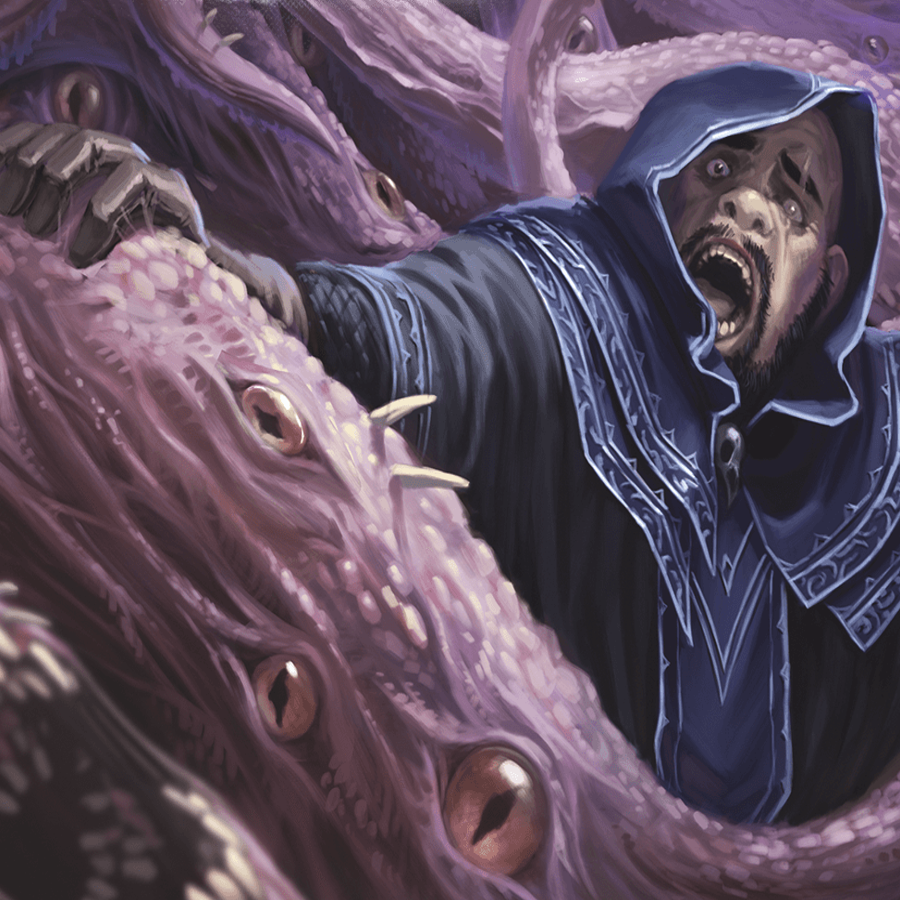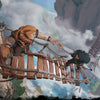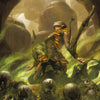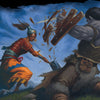When D&D Players Go Off the Rails: Handling the Unexpected as a Game Master

By Luke Hart
Everything is on track for an amazing D&D game session. You’ve done everything you’re supposed to have done. In the last game session, you asked your players what they wanted to do next, and despite 20 minutes of indecision and hemming and hawing, you managed to get a unanimous response out of them. In between game sessions, you designed the adventure, ensuring that you included all three pillars of gameplay, encounters of varying difficulties, a cool environment, and a—hopefully—memorable boss fight. Thus, you show up for this game session excited and confident that everyone is going to have a blast.
And what do your dear beloved players do? They change their minds, of course. That thing they decided to do in the last game session; yeah, they don’t want to do that anymore. Instead, they want to do that other thing, the thing you didn’t prepare for one lick.
And thus, your nightmare begins. How do you survive the game session? How do you come up with content for your players? And, more importantly, perhaps, how do you deal with their treachery? How best can you extract a pound of flesh as recompense?
There are three basic approaches to this dreaded situation, and as luck would have it, that’s what we’ll cover in this article today.
By the way, if you'd like to get your hands on the definitive 5e resource anthology, you got to check out Lairs & Legends 2 and Loot & Lore 2. Get your hands on the biggest and baddest 5e game master resources you’ve laid eyes on!
- Over 30 Adventures
- 30 Stand-Alone Encounters
- More than 100 Monsters
- 6 New Rule Sets
- And much more!
Watch or listen to this article by clicking on the video below.
Level with Your Players
Look, there is nothing wrong with simply telling your players something like this: “So, last time, guys, you all said you wanted to go to the Dungeon of Dread and rescue the dragon from the wicked princess. However, now, you’re saying you want to break into the King’s Palace and jailbreak the dragon’s eggs. You know that I was going to plan the Dungeon of Dread for this game session, but now you’re changing your minds, what gives?”
Now, check this out. Notice how you don’t have to ask the players if you could do the Dungeon of Dread instead because you have already prepped for it. And you don’t need to tell them they are all doing it instead. All you need to do here is simply lay out the facts: They said X, which resulted in you doing Y, but now they are saying Z. By stating the facts in this manner, you are implying that they should hold up what they said they were going to do, but you are not explicitly asking or telling them to. You want this to be subtle; you’re hoping that playing on the idea of keeping one’s word—and perhaps a tad on guilt—will result in their choosing to go to the Dungeon of Dread as they had originally decided.
Of course, this may not work. And if it doesn’t, there is nothing wrong with asking them to go to the Dungeon of Dread, but I’ll tell you this: it’s much better to allow your players to choose. If you pressure them into doing a thing, their hearts probably won’t be in it, and it may feel like you are railroading them. It’s almost always better to let players choose; it simply results in a better game, in my experience.
Now, yes, we can argue about whether it’s an illusion of choice or not all day long, but even the illusion of choice is more satisfying than no choice.
So, the question then is, what do you do if your players decide to go to the King’s Palace and jailbreak the dragon’s eggs despite your reminder of their previous decision? Well, you have two basic options.
Improvise
Look, this is the game master life. The chances of you never having to improvise something are incredibly slim. For me, it varies, but anywhere from 25–50% of every game session I run will involve improvising stuff on the spot. I generally prep my adventures quite thoroughly, but one, it’s impossible for me to predict everything my players will do or everything I might need, and two, there are some things I’m good at improving, so I don’t spend much or any time planning them.
So, in the rare instance when my players do go off and do something unexpected—I say rare because ONE I’m pretty good at dropping plot hooks they’ll follow and two I have amazing players who work with me and don’t intentionally subvert what has been planned. But when they do go “off the rails” so to speak, I just improvise things on the spot, and this is what I suggest you do, too.
Yes, it can be nerve-wracking, and if you’re a new game master, doubly so because you don’t have years of experience to fall back on. However, the more you do it, the better you’ll get. Now, more than likely, what you improvise won’t be as good as something you plan in advance, but remember, you only need to get through this game session. And then you’ll have two weeks or so to plan out the rest of the adventure. So, just struggle your way through it; things will be fine.
Now, I have an entire video on improvisation that you might find helpful—I’ll link that below—but I’ll give you a few steps and guidelines that you can follow to get yourself through this game session.
First, going on an adventure usually involves traveling from point A to point B. So, while they are traveling, you can have a random encounter happen, or they can run across a Point of Interest. This will usually take up to 30 minutes to an hour of game time.
Now, I personally rarely have truly random encounters; instead, my “random” encounters are actually planned, and I usually have a few prepared in advance. They often reinforce the central theme or plot of the campaign and usually utilize cool monsters I’m trying to use somewhere but don’t necessarily want to theme an entire adventure around. So, I’ll slip one of those encounters in. Remember, a good “random” encounter will have context around it; monsters don’t just pop up out of nowhere. No, they have a purpose for being there and a motivation or goal.
Now, points of interest are usually even better than random encounters. The essence of using points of interest is having a way for your players to discover cool and interesting things while traveling; hidden locales, dangerous secrets—that sort of thing. We don’t have to delve into the specifics of creating points of interest right now, but if you’d like to learn more, see my video on points of interest.
The point is that while the group is traveling to the adventure location, in this case, the King’s Palace, you throw in a random encounter or point of interest. This buys you time and would have happened even if you had planned the adventure ahead of time.
Now, once your players arrive at the adventure location, you’ll need something for them to do, and it sure would be great if you also had a map for the adventure. This may seem like a tall order, but it isn’t that bad. To help us accomplish the “something to do” part, we’re going to consider the standard five-room dungeon construction.
If you’re not familiar with a five-room dungeon, it follows a simple design concept. Basically, each “dungeon” or adventure has five parts to it:
- The entrance and guardian.
- A puzzle or social interaction challenge.
- A trick or setback.
- The climax or big battle.
- A reward, revelation, or plot twist.
Now, you won’t worry about all five of them during this game session—remember, you’re just trying to survive. Instead, focus on the first two. If you can come up with an entrance to the King’s Palace and a guardian, then a social interaction or puzzle, it will probably be enough to get you to the end of the game session. So, what you want to do during the first part of the game session, random encounter, or point of interest is whenever your players are talking among themselves or deciding what to do, you should be thinking about and planning those two elements.
Normally, I recommend that the game master listen to players when they are discussing things, as it can be extremely helpful, but the situation is extraordinary and requires that you plan the next part of the game session while they talk. So, tune your players out and get things squared away.
So, of our King’s Palace, let’s say there is a mote of lava and flames around the castle, the drawbridge is down, but so is the portcullis. That’s the entrance. The players need to figure out a way in.
However, there are a dozen gargoyles perched about the battlements, just waiting . . . and when the players enter, they swoop down upon them, defending the castle. As combat ensues, and as the players destroy the gargoyles, they notice more gargoyles re-growing upon the battlements, animating and swooping down. Crap, they never stop. But that’s a puzzle for them. There’s a much larger gargoyle in the courtyard that doesn’t animate, but every time a gargoyle is destroyed, it glows for one round, during which time another gargoyle re-grows. That’s the key—the larger gargoyle. Destroy it, and the smaller gargoyles stop reanimating.
So, the larger gargoyle falls into dozens of pieces as your players smash it apart, but that triggers an alarm in the castle, alerting the majordomo. This elven servant of the evil princess emerges onto a balcony and begins to converse with the players, and. . . .
Well, there you go. Believe it or not, I literally improvised all that just now. No thinking, just one idea leading to the next and rolling with it. And that is probably enough to get you to the end of the game session. We had an encounter, a very basic puzzle, and a social interaction. Now, in between sessions, you can plan out the rest. Of course, you would need to calculate the gargoyle encounter to make sure it was of the appropriate strength, but online encounter planning tools exist for games like D&D and Pathfinder 2 and can make that fast and easy to do during a game session. Really, there’s nothing we did there that couldn’t be done on the fly.
The only really challenging part might be coming up with a map. Now, if you’re playing in person, this is easy. Just draw something on the dry-erase mat. If you’re playing online, it’s more challenging, of course. However, maybe you can simply run this game session using Theater of the Mind. This removes the need for a map entirely. If you’d like some guidance and tips on running Theater of the Mind, check out my video on the topic.
Stall. Stall like your Life Depends on It.
Every game master has been here. Your players want to go to the King’s Palace, and you have absolutely no idea what to do. You don’t have a map; you have no idea what’s in the palace. What are the guards? The encounters? Boss fight? Holy crap, there is no way you can do this. Panic flames your soul, and it’s all you can do not to break down completely. Your brain is melting. Everything I laid out for how to improvise made sense, but now, in the moment, you just—can’t—think.
It’s okay, breathe. Try to relax. Remember, at the end of the day, everything will be fine. Even if your game session sucks—so what? Who cares? Every GM has bad sessions. If this one isn’t so great, your game will survive. What’s more, I personally would much rather have a game session that I wasn’t able to plan for due to no fault of my own—right players?—be the one that sucks rather than the one that I did plan for.
What’s more, your players will know that they pulled a switcheroo on you and that you’re just pulling stuff out of your butt the best you can, and if the game session isn’t so great, that might encourage them not to do that sort of thing in the future. Of course, on a side note, if you do a spectacular job with this game session, they might do it more often. But don’t worry about that. In fact, forget I mentioned it.
Anyway, back to stalling. At this point, you’re less concerned about running an amazing game and more concerned with just preventing the players from reaching the King’s Palace in this game session. That’s . . . what . . . stalling . . . is.
Now, we already mentioned one way to stall: a random encounter or point of interest while they travel to the King’s Palace. However, there are other ways to stall besides just bombarding them with random encounters, which you could technically do if you must.
Basically, you can use anything that takes up game time. Are your players trying to make a decision about something? Is the conversation dragging on for a while—15, 20, 30 minutes? Do you normally step in and encourage them to pick something before then? Well, just let it carry on a bit longer. They probably won’t notice anyway.
Does a side conversation come up about the most recent Playstation game? Okay, let them talk about that more than you normally would; don’t jump in and bring things back to Pathfinder just yet. Remember, you’re stalling!
Did the pizza just arrive? Great, you need to eat, and you’re going to do that before you pick the game back up. Twenty-minute break for everyone!
Of course, if you know that you panic when it comes to improvising, I strongly suggest having a handful of pre-made encounters, points of interest, social interactions, and other game elements ready to go in case of emergencies. And then, when needed, you reach into this Stall Bag and pull out whatever you need.
Now, at this point, you’re probably saying that what I’m suggesting is less than ideal, and you’re 100% right. This is your last recourse. This is your last act of desperation. No, it’s not ideal. No, the game session probably won’t be great. But if your players refuse to go to the Dungeon of Dread, which you actually prepared for them, and you are just not able to improvise the beginning of the King’s Palace, then what are you left with? Sure, you could just end the game session, but that would really suck, in my opinion.
Remember, many players enjoy the act of hanging out with their friends just as much as they enjoy actually playing the game, so if you can give them a pretense of a game to justify hanging out with their friends, they’ll probably be okay with that.
Now, if you’d like to learn why your players keep leaving your games, check out this article right here. And until next time, happy game mastering!
Lairs & Legends 2 - The Definitive 5e Resource Anthology for GMs
Lairs & Legends 2 is not only two hefty books packed full of adventures, monsters, traps, and puzzles. It’s a resource anthology designed to help you run and play amazing games!
Contained in these books, you’ll find:
- 30 Adventures
- Over 100 Monsters
- 30 Traps
- 30 Puzzles
- 30 Stand-Alone Encounters
- 20 New Magic Items
- 6 Custom Rule Sets
- 20 Monster Templates
- 3 Sets of Random Tables
Running awesome 5e games with in-depth lore, deadly traps, and terrifying monsters doesn’t have to take hours of prep! Lairs & Legends 2 and Loot & Lore 2 have everything you need!
Hand-crafted by a team of professional game masters to make it as easy to use as possible, it’s an anthology of game master resources to fuel you for years to come!
-
Posted in
Game Master How-To Articles






